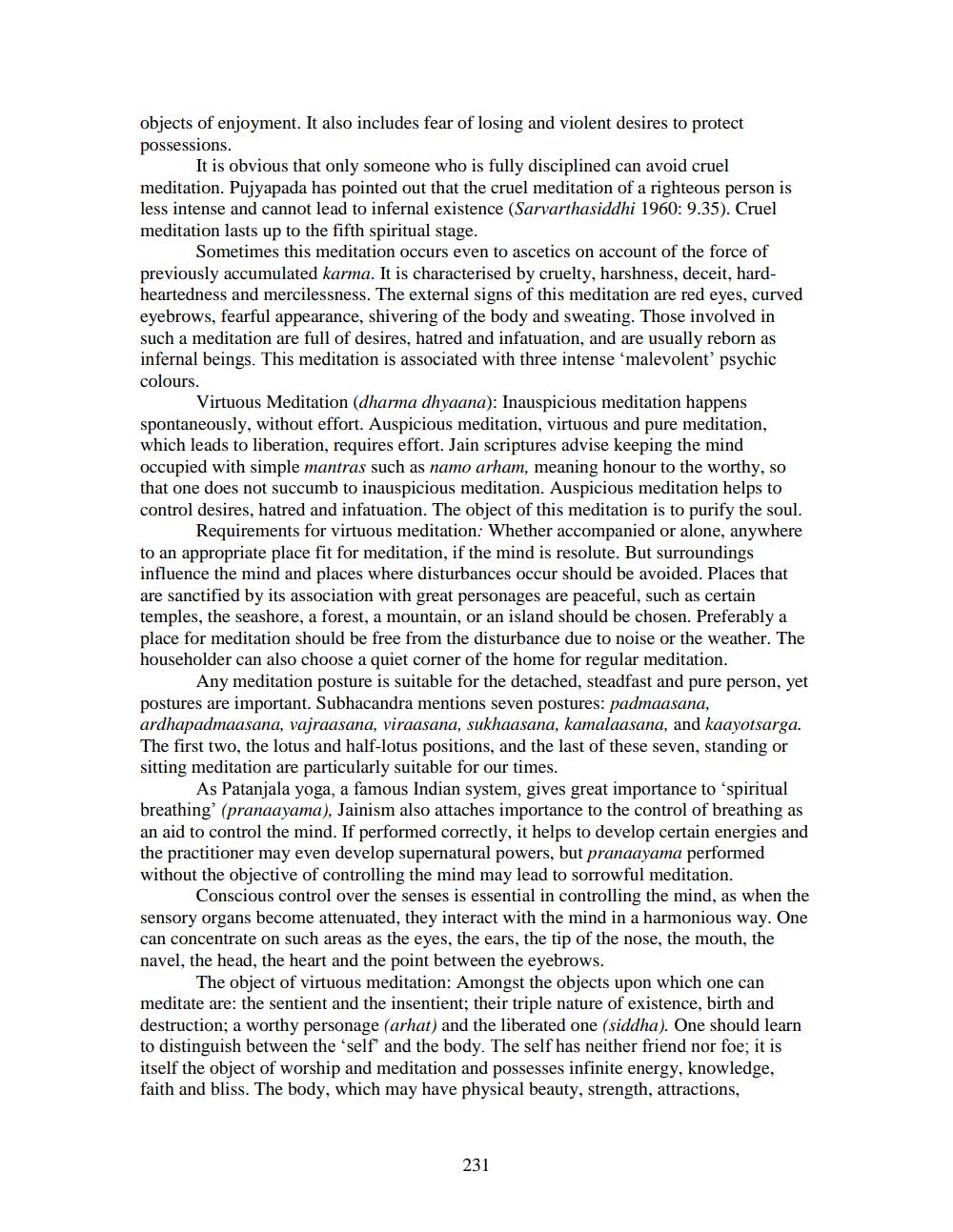________________
objects of enjoyment. It also includes fear of losing and violent desires to protect possessions.
It is obvious that only someone who is fully disciplined can avoid cruel meditation. Pujyapada has pointed out that the cruel meditation of a righteous person is less intense and cannot lead to infernal existence (Sarvarthasiddhi 1960: 9.35). Cruel meditation lasts up to the fifth spiritual stage.
Sometimes this meditation occurs even to ascetics on account of the force of previously accumulated karma. It is characterised by cruelty, harshness, deceit, hardheartedness and mercilessness. The external signs of this meditation are red eyes, curved eyebrows, fearful appearance, shivering of the body and sweating. Those involved in such a meditation are full of desires, hatred and infatuation, and are usually reborn as infernal beings. This meditation is associated with three intense 'malevolent' psychic colours.
Virtuous Meditation (dharma dhyaana): Inauspicious meditation happens spontaneously, without effort. Auspicious meditation, virtuous and pure meditation, which leads to liberation, requires effort. Jain scriptures advise keeping the mind occupied with simple mantras such as namo arham, meaning honour to the worthy, so that one does not succumb to inauspicious meditation. Auspicious meditation helps to control desires, hatred and infatuation. The object of this meditation is to purify the soul. Requirements for virtuous meditation: Whether accompanied or alone, anywhere to an appropriate place fit for meditation, if the mind is resolute. But surroundings influence the mind and places where disturbances occur should be avoided. Places that are sanctified by its association with great personages are peaceful, such as certain temples, the seashore, a forest, a mountain, or an island should be chosen. Preferably a place for meditation should be free from the disturbance due to noise or the weather. The householder can also choose a quiet corner of the home for regular meditation.
Any meditation posture is suitable for the detached, steadfast and pure person, yet postures are important. Subhacandra mentions seven postures: padmaasana, ardhapadmaasana, vajraasana, viraasana, sukhaasana, kamalaasana, and kaayotsarga. The first two, the lotus and half-lotus positions, and the last of these seven, standing or sitting meditation are particularly suitable for our times.
As Patanjala yoga, a famous Indian system, gives great importance to 'spiritual breathing' (pranaayama), Jainism also attaches importance to the control of breathing as an aid to control the mind. If performed correctly, it helps to develop certain energies and the practitioner may even develop supernatural powers, but pranaayama performed without the objective of controlling the mind may lead to sorrowful meditation.
Conscious control over the senses is essential in controlling the mind, as when the sensory organs become attenuated, they interact with the mind in a harmonious way. One can concentrate on such areas as the eyes, the ears, the tip of the nose, the mouth, the navel, the head, the heart and the point between the eyebrows.
The object of virtuous meditation: Amongst the objects upon which one can meditate are: the sentient and the insentient; their triple nature of existence, birth and destruction; a worthy personage (arhat) and the liberated one (siddha). One should learn to distinguish between the 'self' and the body. The self has neither friend nor foe; it is itself the object of worship and meditation and possesses infinite energy, knowledge, faith and bliss. The body, which may have physical beauty, strength, attractions,
231




